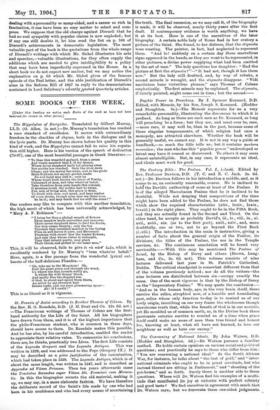St. Francis of Assisi according to Brother Thomas of Celano.
By the Rev. H. G. Rosedale, D.D. (J. M. Dent and Co. 12s. 6d. net.) —The Franciscan writings of Thomas of Celano are the first- hand authority for the Life of the Saint. All his biographers have drawn from them, and it is of the highest importance that the philo-Franciscan student, who is common in these days, should have access to them. Dr. Rosedale makes this possible. And he has also, by his careful introduction, enabled the reader to appreciate their relative value. To summarise his conclusions, there are, he thinks, practically two Lives. The first Life consists of the Legenda G-regorii and the Legenda Antigua. This was written in 1229, and was addressed to the Pope (Gregory IX.) It may be described as a piece justificative of the canonisation, which had taken place in 1228. The Legenda Antigua, which is of about the same length, was written in 1247, and is described as Appendix ad Vitam Prirnam. Then ten years afterwards came the Tractatus Secundus super Vitam Sti. Francisci runs ilfirecu- lis. In this the biographer recasts the old material, making it up, we may say, in a more elaborate fashion. We have therefore the deliberate record of the Saint's life made by one who had been in hip confidence and who had every means of ascertaining the truth. The final recension, as we may call it, of the biography is made, it will be observed, nearly thirty years after the first draft. If contemporary evidence is worth anything, we have it at its best. Here is one of the narratives of the later biography. A certain noble lady of Rome had in her oratory a picture of the Saint. She found, to her distress, that the stigmata were wanting. The painter, in fact, had neglected to represent them. "And lo ! suddenly on a certain day those marvellous signs appeared in the hands, as they are wont to be represented, in other pictures, a divine power supplying what had been omitted by the art of man." The lady questions her daughter: "Had the picture at first the stigmata?"—"It had not, though it has them now." But the lady still doubted, and, by way of rebuke, a second miracle is wrought, and the stigmata disappear. " Vidi maritatam hanc virtutibus plenam," says Thomas of Celano emphatically. The first miracle may be explained. The stigmata, if faintly painted, might come out in time; but the second—


































 Previous page
Previous page